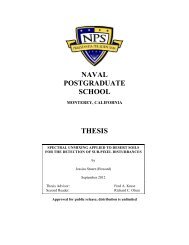October 2000 Newsletter - Naval Postgraduate School
October 2000 Newsletter - Naval Postgraduate School
October 2000 Newsletter - Naval Postgraduate School
You also want an ePaper? Increase the reach of your titles
YUMPU automatically turns print PDFs into web optimized ePapers that Google loves.
MISSILE DEFENSE RESEARCH, continued from page 3<br />
sary has any capability to strike targets in the U. S. with<br />
nuclear missiles, U. S. actions toward that adversary will be<br />
different than they would be towards a comparable nonnuclear<br />
state. Research is continuing into the degree to<br />
which deployment of National Missile Defense systems of<br />
varying degrees of ABM treaty compliance would affect this<br />
vulnerability, if at all. In the tactical sense, the technical<br />
capability exists (even if actual systems are not yet deployed)<br />
to target ships at sea with long-range ballistic missiles. Theater<br />
missile defense developments have concentrated first on<br />
shorter-range (SCUD-like) missiles. Even the most ambitious<br />
theater defense systems are limited (by the ABM Treaty) in<br />
the kinds of missiles they can engage. Research in this area is<br />
focusing on the potential mismatch between projected<br />
defensive capabilities and potential offensive capabilities and<br />
on how this mismatch might be affected by proposed changes<br />
to relevant treaties.<br />
The Total Ship System Engineering (TSSE) Program under<br />
the leadership of Professor Charles Calvano, Department of<br />
Mechanical Engineering, and Robert Harney is a formal<br />
partner in the Capabilities of the Navy After Next (CNAN)<br />
Study funded jointly by DARPA and the <strong>Naval</strong> Warfare<br />
Development Command. During the six-month long<br />
capstone design project, the TSSE student team is investigating<br />
the problem of access assurance and defining (in a<br />
detailed conceptual design) a new class of small, versatile<br />
surface combatants for facilitating access in a network-centric<br />
environment. It is envisioned that the survivable, yet expendable<br />
“boats” would deploy networks of sensors and weapons<br />
throughout the adversary’s access denial zone. Once in place,<br />
these assets would ultimately be used to negate the denial<br />
systems. One component of the adversary’s denial strategy<br />
may well involve the use of terminally guided, longer-range<br />
ballistic missiles against our power projection forces once they<br />
have entered the denial zone. As a consequence, CNAN is<br />
considering the problems and benefits associated with deploying<br />
freestanding, canisterized, TBMD assets such as SM-3<br />
missiles deep into the access denial zone. Such forward<br />
placement could significantly improve the force protection<br />
capabilities of these missiles when compared to basing the<br />
missiles on ships of the power projection forces. If the TSSE<br />
team concludes that SM-3 forward basing is a significant<br />
requirement, then such weapons would be included in the<br />
overall mix of sensors and weapons that the CNAN combatants<br />
would be required to deploy, and as such would influence<br />
the design of those combatants. The TSSE student team is<br />
RESEARCH OVERVIEW<br />
expected to brief their results in late November <strong>2000</strong>.<br />
Detection and Tracking: Intercepting the TBM in the<br />
Atmosphere<br />
For the past three years, Associate Professor Robert G.<br />
Hutchins and Professor Emeritus Hal Titus of the Department<br />
of Electrical and Computer Engineering have been<br />
engaged in TBMD studies to develop sensor fusion, data<br />
association and tracking algorithms to provide the earliest<br />
possible detection and tracking information to the interceptor<br />
launch site. Hence, they have focused on intercepting the<br />
TBM in the atmosphere on the way up. This work has been<br />
funded by the Navy TENCAP Office.<br />
The research objective is to develop sensor fusion, data<br />
association and tracking algorithms, based on a variety of<br />
sensor assets, which will provide the earliest possible detection<br />
and tracking information for use in ballistic missile defense.<br />
All possible sensors from strategic and theater platforms<br />
(space, ship, aircraft, UAV) will be utilized to provide the<br />
fastest missile intercept reaction time possible. The aim is to<br />
bring to bear all assets available to cover a threatened launch<br />
area and to fuse these observations as quickly as they are<br />
obtained. This will allow the shooter to launch at the earliest<br />
possible time. Rapid ballistic missile launch point prediction<br />
is another research objective. Longer-term studies will assess,<br />
via simulation, the feasibility of intercepting the ballistic<br />
missile during ascent using aerodynamic missiles fired from<br />
the surface and/or airborne platforms.<br />
Research has focused on two types of sensors, space based<br />
strategic sensors that would likely provide the first indication<br />
of a missile launch, and the Aegis radar system as the most<br />
likely system to take a hand-off from the strategic sensor to<br />
track the TBM until final intercept, although the algorithms<br />
developed would allow processing of a much wider variety of<br />
sensor types. One issue explored here is how good the<br />
initial velocity and acceleration measurements must be in<br />
order for the surface-based radar system to take over the target<br />
track with a minimum of transient behavior in the track. It<br />
was found that prior information on missile velocity and<br />
acceleration profiles are extremely helpful in track initiation<br />
for the surface-based radar system. Hutchins and Titus have<br />
advocated a modified Kalman-based tracking algorithm that<br />
allows processing measurements from a wide variety of<br />
sensors, provided a common coordinate system framework<br />
can be maintained. Both polynomial backfit and Kalman-<br />
--continued on page 5<br />
NPS Research page 4<br />
<strong>October</strong> <strong>2000</strong>
















